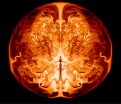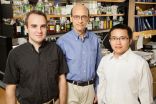(Press-News.org) About 210 million years ago when the supercontinent of Pangea was starting to break up and dog-sized dinosaurs were hiding from nearly everything, entirely different kinds of reptiles called phytosaurs and rauisuchids were at the top of the food chain.
It was widely believed the two top predators didn't interact much as the former was king of the water, and the latter ruled the land. But those ideas are changing, thanks largely to the contents of a single bone.
In a paper published online in September in the German journal Naturwissenschaften, Stephanie Drumheller of the University of Tennessee and Michelle Stocker and Sterling Nesbitt, vertebrate paleontologists with the Virginia Tech's Department of Geosciences, present evidence the two creatures not only interacted, but did so on purpose.
"Phytosaurs were thought to be dominant aquatic predators because of their large size and similarity to modern crocodylians," said Stocker, "but we were able to provide the first direct evidence they targeted both aquatic and large terrestrial prey."
The evidence? A tooth. Not just any tooth, but the tooth of a phytosaur lodged in the thigh bone of a rauisuchid, a creature about 25 feet long and 4 feet high at the hip. The tooth lay broken off and buried about two inches deep in bone, and then healed over, indicating the rauisuchid survived the attack.
"Finding teeth embedded directly in fossil bone is very, very rare," Drumheller said. "This is the first time it's been identified among phytosaurs, and it gives us a smoking gun for interpreting this set of bite marks."
The researchers came across the bone by chance at the University of California Museum of Paleontology in Berkeley.
"It was remarkable we were able to reconstruct a part of an ancient food web from over 210 million years ago from a few shallow marks and a tooth in a bone," said Nesbitt. "It goes to show how careful observation can lead to important discoveries even when you're not seeking those answers.
"We came across this bone and realized pretty quickly we had something special," Nesbitt said. "There are many bones that get dug up, not all are immediately processed, prepared, and studied. No one had recognized the importance of this specimen before but we were able to borrow it and make our study."
The large rauisuchid thigh bone at the center of the research has the tooth of the attacker, which the researchers recreated using CT scans and a 3-D printer. Multiple bite marks indicate the creature was preyed upon at least twice over the course of its life, by phytosaurs.
"This research will call for us to go back and look at some of the assumptions we've had in regard to the Late Triassic ecosystems," Stocker said. "The distinctions between aquatic and terrestrial distinctions were over-simplified and I think we've made a case that the two spheres were intimately connected."
INFORMATION:
The Paleobiology and Geobiology Research Group at Virginia Tech is ranked among the top 10 schools in the nation for paleontology. Stocker and Nesbitt joined the research group in 2013, and together with paleobiologist Shuhai Xiao, have renovated the paleontology labs in order to amplify graduate and undergraduate student experiences.
More resources are available at Virginia Tech News.
Tooth buried in bone shows prehistoric predators tangled across land, sea
Paleontologists find evidence for 210-million-year-old top predator interaction
2014-09-29
ELSE PRESS RELEASES FROM THIS DATE:
Simulations reveal an unusual death for ancient stars
2014-09-29
Certain primordial stars—those 55,000 and 56,000 times the mass of our Sun, or solar masses—may have died unusually. In death, these objects—among the Universe's first-generation of stars—would have exploded as supernovae and burned completely, leaving no remnant black hole behind.
Astrophysicists at the University of California, Santa Cruz (UCSC) and the University of Minnesota came to this conclusion after running a number of supercomputer simulations at the Department of Energy's (DOE's) National Energy Research Scientific Computing Center (NERSC) and Minnesota Supercomputing ...
Myriad presents tumor BRACAnalysis CDx study at ESMO
2014-09-29
SALT LAKE CITY, Utah, Sept. 29, 2014 – Myriad Genetics, Inc. (Nasdaq: MYGN) today announced that its Tumor BRACAnalysis CDx™ companion diagnostic test significantly improved the detection of cancer-causing BRCA1/2 mutations by 44 percent in women with ovarian cancer. Data from this new study were presented at the 2014 European Society for Medical Oncology (ESMO) annual meeting in Madrid, Spain.
"Several previous clinical studies have demonstrated that patients with germline or somatic BRCA1/2 mutations respond to certain DNA-damaging medicines such as the platinum ...
Cells from placentas safe for patients with multiple sclerosis
2014-09-29
Patients with Multiple Sclerosis (MS) were able to safely tolerate treatment with cells cultured from human placental tissue, according to a study published today in the journal Multiple Sclerosis and Related Disorders. The study, which is the first of its kind, was conducted by researchers at Mount Sinai, Celgene Cellular Therapeutics subsidiary of Celgene Corporation and collaborators at several other institutions.
While designed to determine safety of the treatment, early signals in the data also suggested that a preparation of cultured cells called PDA-001 may repair ...
Greenland Ice Sheet more vulnerable to climate change than previously thought
2014-09-29
A new model developed by researchers at the University of Cambridge has shown that despite its apparent stability, the massive ice sheet covering most of Greenland is more sensitive to climate change than earlier estimates have suggested, which would accelerate the rising sea levels that threaten coastal communities worldwide.
In addition to assessing the impact of the increasing levels of meltwater created and spilled into the ocean each year as the climate continues to warm, the new model also takes into account the role that the soft, spongy ground beneath the ice ...
Scientists discover a new role for estrogen in the pathology of breast cancer
2014-09-29
CHAMPAIGN, Ill. — Scientists have discovered a previously unknown mechanism by which estrogen prepares cells to divide, grow and, in the case of estrogen-positive breast cancers, resist cancer drugs. The researchers say the work reveals new targets for breast cancer therapy and will help doctors predict which patients need the most aggressive treatment.
The University of Illinois team reports its findings in the journal Oncogene.
Estrogen pre-activates the unfolded-protein response (UPR), a pathway that normally protects cells from stress, the researchers report. The ...
Climate change appears a mixed bag for a common frog
2014-09-29
Scientists have found amphibians worldwide are breeding earlier due to climate change, but how that affects species is just now being answered.
After warmer winters, wood frogs breed earlier and produce fewer eggs, a Case Western Reserve University researcher has found.
Michael F. Benard, the George B. Mayer Chair in Urban and Environmental Studies and assistant professor of biology, also found that frogs produce more eggs during winters with more rain and snow.
Benard's study, published today in the journal Global Change Biology, is among the first in a natural habitat ...
After-school exercise program enhances cognition in 7-, 8- and 9-year-olds
2014-09-29
CHAMPAIGN, Ill. — A nine-month-long, randomized controlled trial involving 221 prepubescent children found that those who engaged in moderate-to-vigorous physical activity for at least 60 minutes a day after school saw substantial improvements in their ability to pay attention, avoid distraction and switch between cognitive tasks, researchers report in the journal Pediatrics.
Half of the study subjects were randomly assigned to the after-school program and the rest were placed on a wait list. All participants underwent cognitive testing and brain imaging before and after ...
Hand size appears to stay constant, providing natural 'ruler'
2014-09-29
People tend to perceive their dominant hand as staying relatively the same size even when it's magnified, lending support to the idea that we use our hand as a constant perceptual "ruler" to measure the world around us. The findings are published in Psychological Science, a journal of the Association for Psychological Science.
"These findings suggest that our bodies are used as perceptual metrics, meaning that we are more likely to attribute changes in the perceived size of the hand to changes in the world — instead of thinking that our hand has become bigger, we're more ...
More children admitted to intensive care but with lower staffing ratios
2014-09-29
More children than ever are being admitted to intensive care units in England and Wales but there are fewer staff per bed available to cope with the increase, according to a new report published jointly by the University of Leeds and University of Leicester.
The Paediatric Intensive Care Audit Network (PICANet) report showed that there was a 15% increase in admissions over a 10-year period between 2004 and 2013, but this included an increase of 4% that was not due to changes in the childhood population.
At the same time, staffing levels have increased by 36% but this ...
Researchers identify early sign of pancreatic cancer
2014-09-28
BOSTON –– Scientists at Dana-Farber Cancer Institute, the Massachusetts Institute of Technology, and other institutions have discovered a sign of the early development of pancreatic cancer – an upsurge in certain amino acids that occurs before the disease is diagnosed and symptoms appear. The research is being published online today by the journal Nature Medicine.
Although the increase isn't large enough to be the basis of a new test for early detection of the disease, the findings will help researchers better understand how pancreatic cancer affects the rest of the body, ...
LAST 30 PRESS RELEASES:
Why nail-biting, procrastination and other self-sabotaging behaviors are rooted in survival instincts
Regional variations in mechanical properties of porcine leptomeninges
Artificial empathy in therapy and healthcare: advancements in interpersonal interaction technologies
Why some brains switch gears more efficiently than others
UVA’s Jundong Li wins ICDM’S 2025 Tao Li Award for data mining, machine learning
UVA’s low-power, high-performance computer power player Mircea Stan earns National Academy of Inventors fellowship
Not playing by the rules: USU researcher explores filamentous algae dynamics in rivers
Do our body clocks influence our risk of dementia?
Anthropologists offer new evidence of bipedalism in long-debated fossil discovery
Safer receipt paper from wood
Dosage-sensitive genes suggest no whole-genome duplications in ancestral angiosperm
First ancient human herpesvirus genomes document their deep history with humans
Why Some Bacteria Survive Antibiotics and How to Stop Them - New study reveals that bacteria can survive antibiotic treatment through two fundamentally different “shutdown modes”
UCLA study links scar healing to dangerous placenta condition
CHANGE-seq-BE finds off-target changes in the genome from base editors
The Journal of Nuclear Medicine Ahead-of-Print Tip Sheet: January 2, 2026
Delayed or absent first dose of measles, mumps, and rubella vaccination
Trends in US preterm birth rates by household income and race and ethnicity
Study identifies potential biomarker linked to progression and brain inflammation in multiple sclerosis
Many mothers in Norway do not show up for postnatal check-ups
Researchers want to find out why quick clay is so unstable
Superradiant spins show teamwork at the quantum scale
Cleveland Clinic Research links tumor bacteria to immunotherapy resistance in head and neck cancer
First Editorial of 2026: Resisting AI slop
Joint ground- and space-based observations reveal Saturn-mass rogue planet
Inheritable genetic variant offers protection against blood cancer risk and progression
Pigs settled Pacific islands alongside early human voyagers
A Coral reef’s daily pulse reshapes microbes in surrounding waters
EAST Tokamak experiments exceed plasma density limit, offering new approach to fusion ignition
Groundbreaking discovery reveals Africa’s oldest cremation pyre and complex ritual practices
[Press-News.org] Tooth buried in bone shows prehistoric predators tangled across land, seaPaleontologists find evidence for 210-million-year-old top predator interaction






